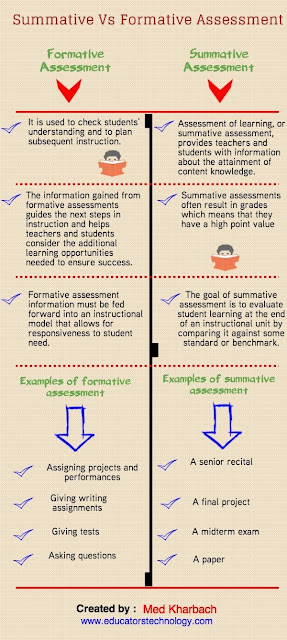WOAH...assessments are multi-facetted. Each article or book I read this week was about a different component of assessment and /or evaluation. I am going to regurgitate some components I found important to recall and highlight before I dive into some information that I learned.
The type of assessment used varies on the class and students. There are multiple forms of assessments besides the traditional exam, which too many students know all to well. The idea of PLANNING resurfaces when discussing assessment because as teachers we need to plan for our students to do well on assessments. Assessments also do not only come at the end of a unit, again a traditional way of thinking, but everyday we are assessing student's performance.
I needed to unpack all of these thoughts and realizations I had while reading before articulating a few of the methods and types of assessments I read about. So now let's dive into the WHAT...
Student assessment and evaluations is the topic of the week. For the past 4 years of my college career I have heard these 2 terms being thrown around:
Formative & Summative
Through the readings this week I was provided clarity and differentiation between the two. it is important to remember both terms are a method of answering the question, "How can you measure student learning?" Both of these methods are systematic processes.
What do you need to know about Formative Assessments?
- What it looks like: Receiving and guiding feedback on their performance
- Not always attached to a students grade
- Allows teachers to gauge where the class is and where it needs to go
- Teachers are measuring performance for a daily or on-going basis
What do you need to know about Summative Assessments?
- What it looks like: Exams, tests, quizzes
- Cumulative
- Used to calculate individual student grades
- Familiar to many of us!
But wait... Curve ball... there is a 3rd way to assess students:
Direct & Indirect
Indirect Assessments: Surveying or observing student learning
Each of these are further detailed out on the CTE website that also elaborates on the rubrics, self and peer assessment, developing good test questions, which are all beneficial resources to utilize when creating lesson and unit plans.
The Triple Threat
There will be encounters will special populations of learners in schools. Exceptional and ELL learners are two examples of special populations, so as educators, how do we grade them fairly? Well the three "P" words helps us answer this question:
Product
Process
Progress
The way I interpret the purpose of the triple threat is that they are each a criteria that breaks down an overall grade. This demonstrates for parents, administration, students, and teachers the learning process and performance of each student. When is comes time for placement decisions, progress reports, or meetings then there is clear evidence of the students performance.

No comments:
Post a Comment